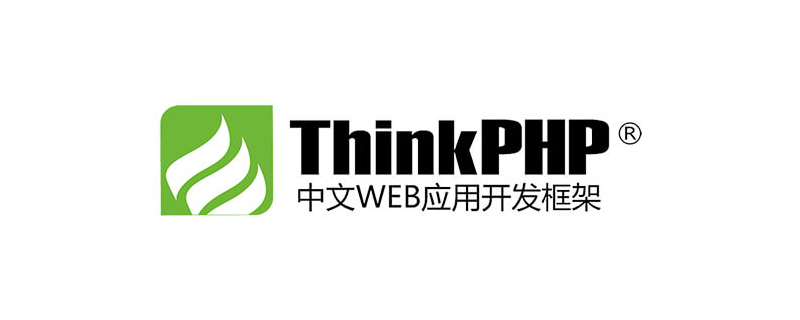thinkphp中介軟體是什麼
ThinkPHP是為了簡化企業級應用開發和敏捷WEB應用開發而誕生的。最早誕生於2006年初,2007年元旦正式更名為ThinkPHP,並遵循Apache2開源協定發布。 ThinkPHP從誕生以來一直秉承簡潔實用的設計原則,在保持出色的性能和至簡的程式碼的同時,也注重易用性。並且擁有眾多原創功能和特性,在社區團隊的積極參與下,在易用性、擴展性和性能方面不斷優化和改進。

thinkphp中間件是什麼?
從5.1.6 版本開始,正式引入中間件的支援。
中間件主要用於攔截或過濾應用的HTTP請求,並進行必要的業務處理。
定義中間件
可以透過命令列指令快速產生中間件
php think make:middleware Check
這個指令會application/http/middleware目錄下面產生一個Check中介軟體.
<?php
namespace app\http\middleware;
class Check
{
public function handle($request, \Closure $next)
{
if ($request->param('name') == 'think') {
return redirect('index/think');
}
return $next($request);
}
}中間件的入口執行方法必須是handle方法,而且第一個參數是Request對象,第二個參數是一個閉包。
中間件handle方法的回傳值必須是一個Response物件。
在這個中間件中我們判斷目前請求的name參數等於think的時候進行重定向處理。否則,請求將進一步傳遞到應用程式中。要讓請求繼續傳遞到應用程式中,只需使用 $request 作為參數去呼叫回調函數 $next 。
在某些需求下,可以使用第三個參數傳入額外的參數。
<?php
namespace app\http\middleware;
class Check
{
public function handle($request, \Closure $next, $name)
{
if ($name == 'think') {
return redirect('index/think');
}
return $next($request);
}
}前置/後置中間件
中間件是在請求特定的操作之前還是之後執行,完全取決於中間件的定義本身。
下面是一個前置行為的中間件
<?php
namespace app\http\middleware;
class Before
{
public function handle($request, \Closure $next)
{
// 添加中间件执行代码
return $next($request);
}
}下面是一個後置行為的中間件
<?php
namespace app\http\middleware;
class After
{
public function handle($request, \Closure $next)
{
$response = $next($request);
// 添加中间件执行代码
return $response;
}
}來個比較實際的例子,我們需要判斷當前瀏覽器環境是在微信或支付寶
namespace app\http\middleware;
/**
* 访问环境检查,是否是微信或支付宝等
*/
class InAppCheck
{
public function handle($request, \Closure $next)
{
if (preg_match('~micromessenger~i', $request->header('user-agent'))) {
$request->InApp = 'WeChat';
} else if (preg_match('~alipay~i', $request->header('user-agent'))) {
$request->InApp = 'Alipay';
}
return $next($request);
}
}然後在你的行動版的module裡加入一個middleware.php檔案
例如:/path/application/mobile/middleware.php
return [
app\http\middleware\InAppCheck::class,
];然後在你的controller中可以透過$this->request->InApp取得相關的值
註冊中間件
路由中間件
最常用的中間件註冊方式是註冊路由中間件
Route::rule('hello/:name','hello') ->middleware('Auth');
或使用完整的中間件類別名稱
Route::rule('hello/:name','hello') ->middleware(app\http\middleware\Auth::class);
支援註冊多個中介軟體
Route::rule('hello/:name','hello') ->middleware(['Auth', 'Check']);
V5.1.7 版本,可以直接在應用程式設定目錄下的middleware.php中先預先定義中間件(其實就是增加別名識別),例如:
return [
'auth'=>app\http\middleware\Auth::class,
'check'=>app\http\middleware\Check::class
];然後直接在路由中使用中間件別名註冊
Route::rule('hello/:name','hello') ->middleware(['Auth', 'Check']);
V5.1.8 版本開始,可以支援使用別名定義一組中間件,例如:
return [
'check'=>[
app\http\middleware\Auth::class,
app\http\middleware\Check::class
],
];然後,直接使用下面的方式註冊中間件
Route::rule('hello/:name','hello') ->middleware('check');
支援對路由分組註冊中間件
Route::group('hello', function(){
Route::rule('hello/:name','hello');
})->middleware('Auth');V5.1.8 版本開始支援對某個網域註冊中間件
Route::domain('admin', function(){
// 注册域名下的路由规则
})->middleware('Auth');如果需要傳入額外參數給中間件,可以使用
Route::rule('hello/:name','hello') ->middleware('Auth:admin');
如果使用的是常數方式定義,可以在第二個參數傳入中間件參數。
Route::rule('hello/:name','hello') ->middleware(Auth::class, 'admin');
如果需要定義多個中間件,使用陣列方式
Route::rule('hello/:name','hello') ->middleware([Auth::class, 'Check']);
可以統一傳入同一個額外參數
Route::rule('hello/:name','hello') ->middleware([Auth::class, 'Check'], 'admin');
或單獨指定中間件參數。
Route::rule('hello/:name','hello') ->middleware(['Auth:admin', 'Check:editor']);
使用閉包定義中間件
你不一定要使用中間件類,在某些簡單的場合你可以使用閉包定義中間件,但閉包函數必須傳回Response物件實例。
Route::group('hello', function(){
Route::rule('hello/:name','hello');
})->middleware(function($request,\Closure $next){
if ($request->param('name') == 'think') {
return redirect('index/think');
}
return $next($request);
});全域中間件
你可以在應用程式目錄下方定義middleware.php文件,使用下面的方式:
<?php
return [
\app\http\middleware\Auth::class,
'Check',
'Hello',
];中間件的註冊應該使用完整的類別名,如果沒有指定命名空間則使用app\http\middleware作為命名空間。
全域中間件的執行順序就是定義順序。可以在定義全域中間件的時候傳入中間件參數,支援兩種方式傳入。
<?php
return [
[\app\http\middleware\Auth::class, 'admin'],
'Check',
'Hello:thinkphp',
];上面的定義表示 給Auth中間件傳入admin參數,給Hello中間件傳入thinkphp參數。
模組中間件
V5.1.8 版本開始,支援模組中間件定義,你可以直接在模組目錄下方增加middleware.php文件,定義方式和應用中間件定義一樣,只是只會在這個模組下面生效。
控制器中間件
V5.1.17 版本開始,支援為控制器定義中間件。首先你的控制器需要繼承系統的think\Controller類,然後在控制器中定義middleware屬性,例如:
<?php
namespace app\index\controller;
use think\Controller;
class Index extends Controller
{
protected $middleware = ['Auth'];
public function index()
{
return 'index';
}
public function hello()
{
return 'hello';
}
}當執行index控制器的時候就會呼叫Auth中間件,一樣支援使用完整的命名空間定義。
如果需要設定控制器中間的生效操作,可以如下定義:
<?php
namespace app\index\controller;
use think\Controller;
class Index extends Controller
{
protected $middleware = [
'Auth' => ['except' => ['hello'] ],
'Hello' => ['only' => ['hello'] ],
];
public function index()
{
return 'index';
}
public function hello()
{
return 'hello';
}
}中間件向控制器傳參
可以透過給予請求物件賦值的方式傳參給控制器(或其它地方),例如
<?php
namespace app\http\middleware;
class Hello
{
public function handle($request, \Closure $next)
{
$request->hello = 'ThinkPHP';
return $next($request);
}
}注意,傳遞的變數名稱不要和param變數有衝突。
然後在控制器的方法裡面可以直接使用
public function index(Request $request)
{
return $request->hello; // ThinkPHP
}本文来自ThinkPHP框架技术文章栏目:http://www.php.cn/phpkj/thinkphp/
以上是thinkphp中介軟體是什麼的詳細內容。更多資訊請關注PHP中文網其他相關文章!

熱AI工具

Undresser.AI Undress
人工智慧驅動的應用程序,用於創建逼真的裸體照片

AI Clothes Remover
用於從照片中去除衣服的線上人工智慧工具。

Undress AI Tool
免費脫衣圖片

Clothoff.io
AI脫衣器

Video Face Swap
使用我們完全免費的人工智慧換臉工具,輕鬆在任何影片中換臉!

熱門文章

熱工具

記事本++7.3.1
好用且免費的程式碼編輯器

SublimeText3漢化版
中文版,非常好用

禪工作室 13.0.1
強大的PHP整合開發環境

Dreamweaver CS6
視覺化網頁開發工具

SublimeText3 Mac版
神級程式碼編輯軟體(SublimeText3)




